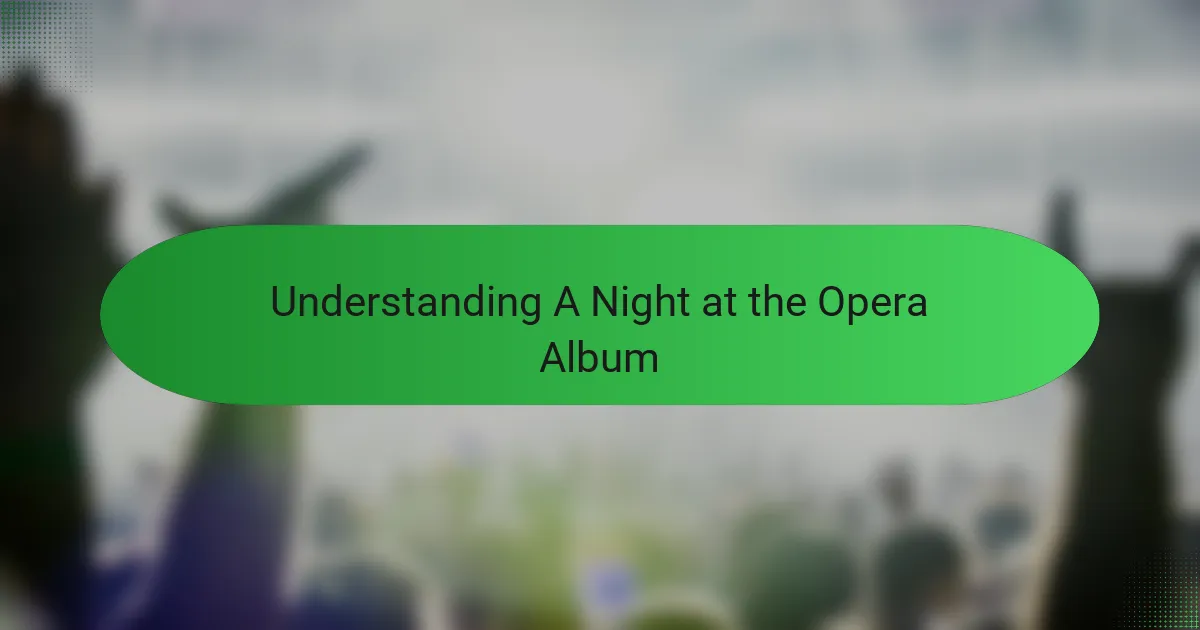Key takeaways
- Queen’s A Night at the Opera is a groundbreaking album that blends diverse musical styles, including opera and hard rock, creating a unique listening experience.
- The album features iconic tracks like “Bohemian Rhapsody” and “You’re My Best Friend,” showcasing a mix of theatricality and emotional depth.
- Released in 1975, it challenged the conventions of rock music at the time, inspiring future artists to rethink album composition and genre fusion.
- Listeners are encouraged to appreciate the album’s intricate layers and contrasts, which reveal new details with each play, enhancing the overall emotional journey.

Understanding A Night at the Opera Album
When I first dove into Queen’s A Night at the Opera, I was amazed by how it breaks the mold of typical rock albums. The way the band blends opera, hard rock, ballads, and even vaudeville in a single record felt like unlocking a new dimension of music. Have you ever listened to something that seemed so bold and experimental yet incredibly cohesive? That’s the magic here.
What struck me most is the album’s ambition. I remember hearing “Bohemian Rhapsody” for the first time and wondering how anyone could put such a complex piece together. It’s not just a song; it’s a mini-opera that challenges the listener to pay attention to every shift in tone and style. Queen’s daring creativity reminded me that rock can be art in the fullest sense.
Listening to A Night at the Opera feels like stepping into a theatrical performance where every track tells a story with its own mood and intensity. It’s an experience that demands more than passive listening, asking you to engage and feel along with every twist and turn. Would you agree that albums like this change how we perceive music as a whole? For me, it set a new standard of what a rock band could achieve.

Overview of Queen as a Rock Band
Queen, to me, has always represented the fearless spirit of rock music. Their willingness to push boundaries and blend genres is something few bands dared to do at the time. I often think about how Freddie Mercury’s dynamic stage presence and the band’s tight musicianship gave them an energy that still feels electric today.
What really makes Queen stand out, in my opinion, is their ability to mix theatrical flair with raw rock power. I recall seeing live footage where their performances felt less like concerts and more like epic storytelling sessions—each member contributing something unique yet perfectly in sync. Don’t you find it fascinating when a band doesn’t just play music but creates an entire world on stage?
I’ve always admired how Queen refuses to be boxed into a single category. Whether it’s the hard-hitting guitar riffs, intricate vocal harmonies, or those surprising operatic elements, their sound is rich and unpredictable. It makes me wonder how many modern rock bands capture that same fearless creativity as Queen did.

Historical Context of the Album Release
Looking back at 1975, when A Night at the Opera was released, I think about the rock scene being dominated by straightforward, guitar-driven sounds. Queen’s decision to push the envelope with such an eclectic album felt like a bold, almost risky move. It makes me wonder—how many bands today are willing to take that kind of artistic gamble and still create something timeless?
The mid-70s were a time of musical experimentation, but Queen took it a step further by weaving together genres that seemed worlds apart. I remember reading about how complex and costly the recording process was, which shows just how committed they were to crafting something truly unique. That kind of dedication really resonates with me, especially knowing how hard it is to balance creativity and commercial success.
I also find it fascinating how the album followed their earlier works that were more traditional rock, marking a clear turning point. Don’t you find it inspiring when a band evolves so dramatically, seemingly overnight? For me, this historical moment is where Queen not only found their signature sound but also reshaped the future of rock music.

Key Tracks and Musical Features
“Bohemian Rhapsody” stands out not just as a key track but as a musical masterpiece that redefined what a rock song could be. When I first heard its operatic sections layered over hard rock, I was completely blown away by how seamlessly Queen blended genres without losing their edge. Have you ever encountered a song that makes you want to replay it just to catch every nuance?
Another track that grabbed my attention is “You’re My Best Friend,” where the warmth of John Deacon’s bass underpins a heartfelt ballad that contrasts beautifully with the album’s bombastic moments. This diversity in mood keeps the album fresh, almost like an emotional rollercoaster I was eager to ride again. It’s this balance of theatrical flair and genuine emotion that, to me, defines Queen’s magic.
Musically, the album’s inventive layering of vocals and instruments is something I find fascinating. The multi-tracked harmonies feel like a choir of voices rather than just a band, enriching each song’s texture with complexity yet clarity. Doesn’t it make you appreciate the painstaking artistry behind the scenes—how every note and harmony is meticulously crafted to serve the song’s story?

Personal Listening Experience and Impressions
Listening to A Night at the Opera for the first time was like stepping into a whirlwind of sound that kept me completely hooked. I found myself caught off guard by how each track revealed something new—whether it was a surprising tempo shift or an unexpected vocal harmony. Have you ever had that feeling where you want to listen to an album on repeat just to catch every detail? That was exactly me with this record.
As the songs unfolded, I was drawn into this emotional journey—from the operatic highs of “Bohemian Rhapsody” to the tender sincerity of “You’re My Best Friend.” It felt personal, like the band was sharing pieces of their soul right through the speakers. For me, not many albums create that kind of connection where you can feel both the grandeur and the intimacy simultaneously.
I also appreciated how the album demanded my full attention, almost like it was a puzzle waiting to be solved. The layers of vocals and instruments weren’t just background noise; each element had a purpose that slowly made sense the more I listened. Don’t you love when music challenges you like that, pulling you deeper with each play? It’s a rare experience that’s hard to forget.

Impact of the Album on Rock Music
When I reflect on the impact of A Night at the Opera on rock music, I’m struck by how it shattered expectations. Queen showed that rock could be grand and theatrical without losing its raw edge. Have you noticed how many bands since then have dared to mix styles boldly, taking cues from this album’s fearless experimentation?
In my experience, this album opened doors for progressive rock and inspired artists to treat albums like cohesive stories rather than just collections of songs. I remember feeling that, after listening to it, the possibilities of rock music felt limitless, almost like a new language was being spoken. Isn’t that what true innovation in music feels like—both exciting and a little intimidating?
What really stuck with me is how A Night at the Opera blurred the lines between high art and popular music. That blend raised the bar for musicianship and showmanship in rock, and I think that’s why the album’s influence still resonates today. Have you ever wondered how a record from the ’70s can still feel so fresh and impactful? To me, that’s the mark of a genuine classic.

Recommendations for New Listeners
If you’re new to Queen or A Night at the Opera, I’d suggest starting with “Bohemian Rhapsody.” It’s a gateway into their world—complex yet unforgettable. When I first listened, I found myself rewinding just to catch every operatic twist and guitar solo, and that sense of discovery really hooked me.
Don’t rush through the album in one sitting; this record deserves multiple listens. I remember how each time I came back, different layers stood out—maybe it was the subtle harmonies or the playful shifts in mood. Have you ever noticed how some albums grow on you, revealing more the deeper you dive? That’s exactly what happens here.
Also, don’t overlook the softer moments like “You’re My Best Friend.” They may seem simple compared to the bombast, but to me, they add heart and balance. Getting comfortable with those contrasts helped me appreciate the album’s full emotional range—something every new listener should experience.